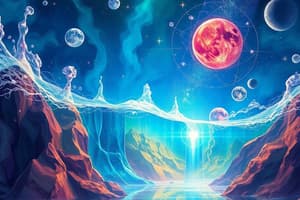Podcast
Questions and Answers
What happens during the melting phase change?
What happens during the melting phase change?
- A substance absorbs heat (correct)
- A substance remains at the same temperature
- A substance releases heat
- A substance changes directly from solid to gas
The freezing point of a substance is always higher than its melting point.
The freezing point of a substance is always higher than its melting point.
False (B)
The process of a liquid turning into a gas is called ________.
The process of a liquid turning into a gas is called ________.
evaporation
At what temperature does ice melt to water?
At what temperature does ice melt to water?
Which phase change occurs when heat is removed from a substance?
Which phase change occurs when heat is removed from a substance?
Match the phase change with the correct description:
Match the phase change with the correct description:
Sublimation occurs when a solid turns directly into a gas.
Sublimation occurs when a solid turns directly into a gas.
Give an example of a substance that undergoes sublimation.
Give an example of a substance that undergoes sublimation.
Increased temperature can enhance the process of ________.
Increased temperature can enhance the process of ________.
What is a phase diagram used for?
What is a phase diagram used for?
Flashcards are hidden until you start studying
Study Notes
Phase Changes in Matter
-
General Concept
- Matter can exist in different phases: solid, liquid, and gas.
- Phase changes occur due to energy changes (usually heat).
-
Melting
- Transition from solid to liquid.
- Occurs when a substance absorbs heat.
- Melting point: specific temperature where this transition occurs.
- Example: Ice melts to water at 0°C.
-
Freezing
- Transition from liquid to solid.
- Occurs when a substance loses heat.
- Freezing point: specific temperature where this transition occurs (same as melting point).
- Example: Water freezes to ice at 0°C.
-
Evaporation
- Transition from liquid to gas.
- Occurs at surface of the liquid at any temperature (not just boiling point).
- Increased temperature or decreased pressure can enhance evaporation.
- Example: Water evaporating at room temperature.
-
Sublimation
- Transition from solid directly to gas without becoming liquid.
- Occurs under specific conditions of temperature and pressure.
- Common in substances with low vapor pressures.
- Example: Dry ice (solid CO2) sublimates to gas.
-
Condensation
- Transition from gas to liquid.
- Occurs when gas cools and loses energy.
- Condensation occurs at the same temperature as evaporation (but in reverse).
- Example: Water vapor condensing into dew on grass.
Additional Points
- Energy Transfer: All phase changes involve energy transfer, either absorbed or released.
- Pressure Influence: Changes in pressure can affect phase transition points (e.g., boiling point increases with pressure).
- Phase Diagrams: Graphical representations showing conditions under which distinct phases occur.
General Concept
- Matter can exist in three primary phases: solid, liquid, and gas.
- Phase changes are driven by energy changes, typically involving the absorption or release of heat.
Melting
- Melting is the transition from solid to liquid, occurring when a substance absorbs heat.
- The melting point is the specific temperature at which a substance transitions from solid to liquid.
- Example: Ice transitions to water at 0°C.
Freezing
- Freezing is the process of a liquid transforming into a solid, occurring when a substance loses heat.
- The freezing point, the temperature at which a substance solidifies, is equivalent to its melting point.
- Example: Water transitions to ice at 0°C.
Evaporation
- Evaporation refers to the change from liquid to gas, happening at the surface of the liquid, regardless of temperature, though it can occur faster at increased temperatures or reduced pressures.
- Example: Water can evaporate at room temperature.
Sublimation
- Sublimation is the direct transition from solid to gas without passing through the liquid phase.
- Specific temperature and pressure conditions are required for sublimation to occur.
- Example: Dry ice (solid carbon dioxide) sublimates into gas.
Condensation
- Condensation is the transformation from gas to liquid, occurring when the gas cools and loses energy.
- The temperature at which condensation occurs is the same as that for evaporation but in reverse.
- Example: Water vapor forms dew on grass.
Additional Points
- Energy transfer is integral to all phase changes, involving either absorption or release.
- Phase transition points can be influenced by changes in pressure, impacting boiling and freezing points.
- Phase diagrams visually represent the conditions (pressure and temperature) under which distinct phases of a substance exist.
Studying That Suits You
Use AI to generate personalized quizzes and flashcards to suit your learning preferences.




